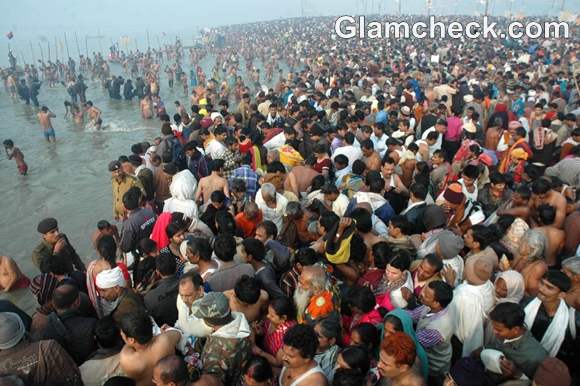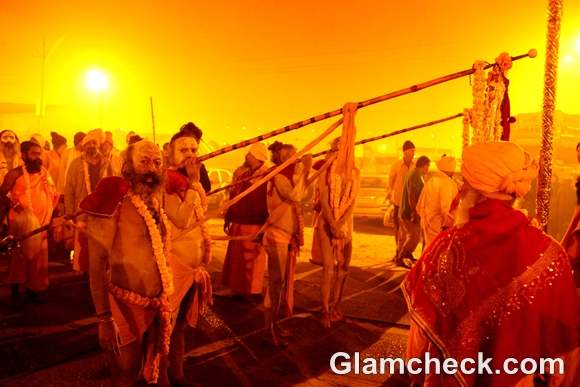They say Faith is the biggest force driving a man. Well, the ongoing Maha Kumbh mela is definitely a sure shot way to prove this faith, where a congregation of estimated 100 million devotees are expected to take a dip in the Holy waters at Allahabad. where there is the tri-river union or Sangam – Ganges, Yamuna and the mythical Saraswati. As is the belief and faith – by doing so the devotee washes away the sins and gets free from the cycle of birth, death and rebirth.
 Maha Kumbh 2013
Maha Kumbh 2013
This year Mahakumbh festival is being held at Allahabad starting on the auspicious day of Makar Sankranti – 14th January, 2013 for a period of 55 days.
Origin and History of the Kumbh mela
Perhaps the earliest mention of the Kumbh mela is found in the diary of the Chinese traveller Huan Tsang. It was made popular in the present form, amongst the masses in the 8th century by the Indian saint Shankara. Today the Mahakumbh Mela is the world’s single biggest gathering under one roof.
 Maha Kumbh Mela 2013 Allahabad
Maha Kumbh Mela 2013 Allahabad
Literally translated Kumbh mela means “pot festival”. The significance of the Kumbh mela lies deep in the history of the Hindu mythology. As per the story, once the arch rivals, the Gods and the demons got together to churn the ocean to extract the nectar of immortality from it. It was agreed upon to share whatever was extracted equally between the two. However, when the pot containing the nectar of immortality was churned out, there was a fight between the two. The fight went on for 12 days and nights, as per the Gods calendar, equivalent to the 12 years of human life. Lord Vishnu flew away with the pot containing the nectar at the end of the 12th night. It is believed that the drops fell off from the pot at four places – Allahabad, Haridwar, Ujjain and Nashik. Consequently, these are the four places where the holy festival of Kumbh takes place, with the Mahakumbh happening every 12 years at Allahabad.
Significance and rituals followed at the MahaKumbh mela
The Mahakumbh mela has great significance for the Hindu religion. It is believed that by participating in the mela and performing the rituals one attains ‘Nirvana’ and is freed from the bond of life and birth. Most of the rituals that are followed have deep rooted belief in the supreme soul stirring power in the waters of the tri river union. Some of the most common activities and rituals that are followed at the Mahakumbh festival are as follows:
- Bathing / taking a dip – The river Ganges holds a much revered place in the Hindu religion and is a part of almost any religious activity undertaken. Taking a dip in the holy waters before sun rise or any time during the day, is hence supposed to cleanse one’s past sins and make the soul ready to go to the next stage. Usually all the 55 days of the festival are considered auspicious, however certain days as per the Hindu lunar calendar are considered more pious in this period. The dates on which the main bathing rituals will happen in 2013 Mahakumbh are – 27th January and in the month of February- 6th,10th, 15th,17th, 18th and 25th. After the religious dip, the devotees don fresh clothes and participate in the other activities / rituals.
- Religious discourses – Often different sects of the holy and learned Hindu ascetics or sadhus hold religious discourses or readings of the Holy scriptures during this period. The three most popular sects of sadhus are – The Vaishnavas (followers of Lord Vishnu), The Shaivas( followers of Lord Shiva)and the Nagas or the naked sadhus who cover themselves with just ash and garlands are considered the most exotic and fervent of the lot. The nagas are part of different ‘Akharas’ or schools. During the holy dip, each Akhara takes out a procession and chant ‘Har Har Mahadev ’ or “Hail Lord Shiva”
- Attending Yoga classes – The ascetics and holy men are often yogis, who have mastered the art of self control and practice difficult asanas of Yoga. Often devotees find themselves drawn towards the yogic postures that the ascetics practise or attend the numerous yoga sessions that are a part of the festivities of the Mahakumbh.
- Staying at the ashrams – Leading a bare existence or living with only the basic necessities at an ashram where the yogis reside is also commonplace. Residing in ashrams helps one to observe the sparse life led by the ascetics and helps reinforce self control and meditation to achieve peace within one’s self.
Words and pictures would perhaps fail to describe the spirit of the Maha Kumbh mela. To experience the true essence of the Kumbh mela, perhaps one should visit the Kumbh mela once in a life time if not more.
Indian Photo Agency
